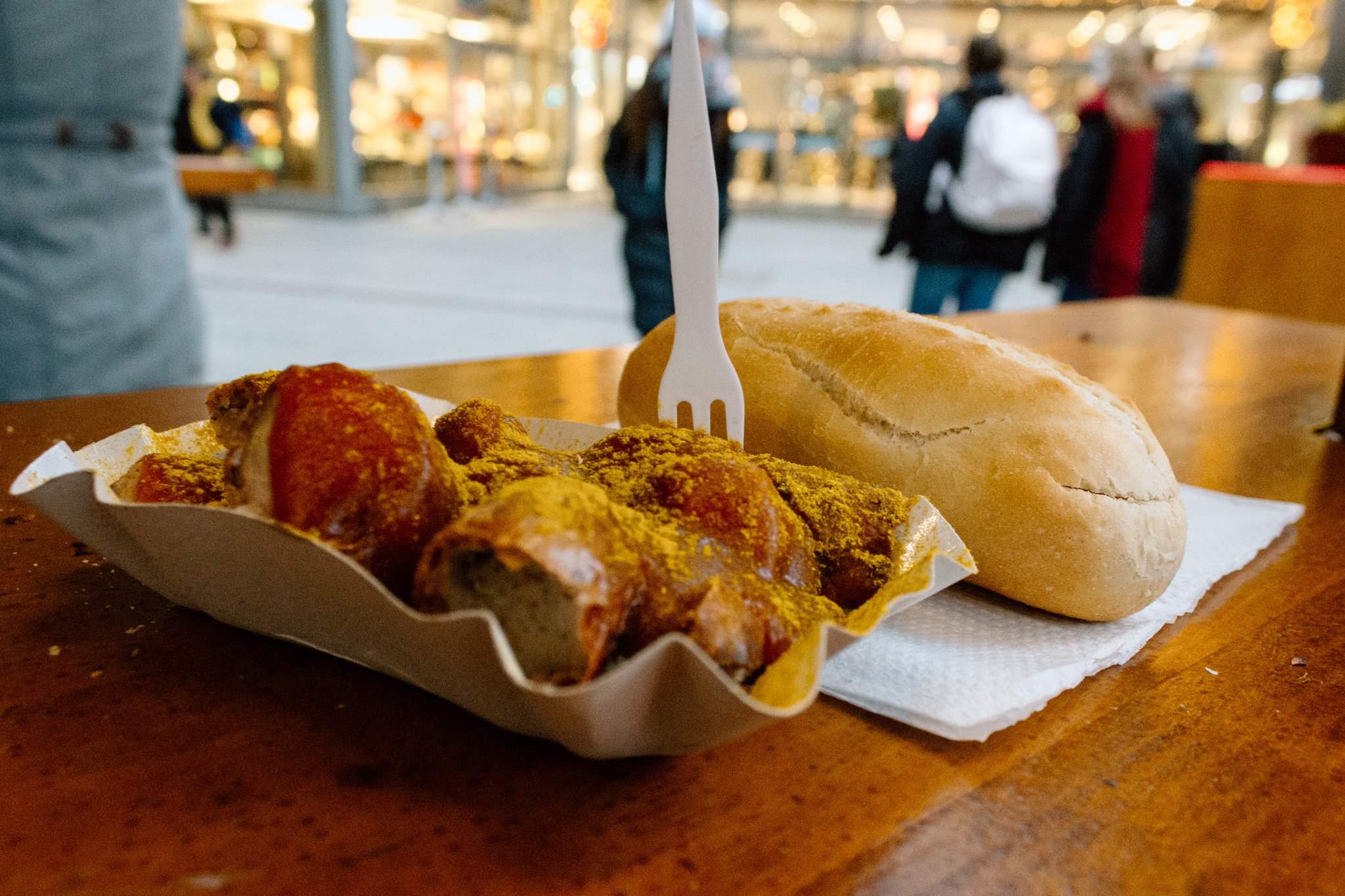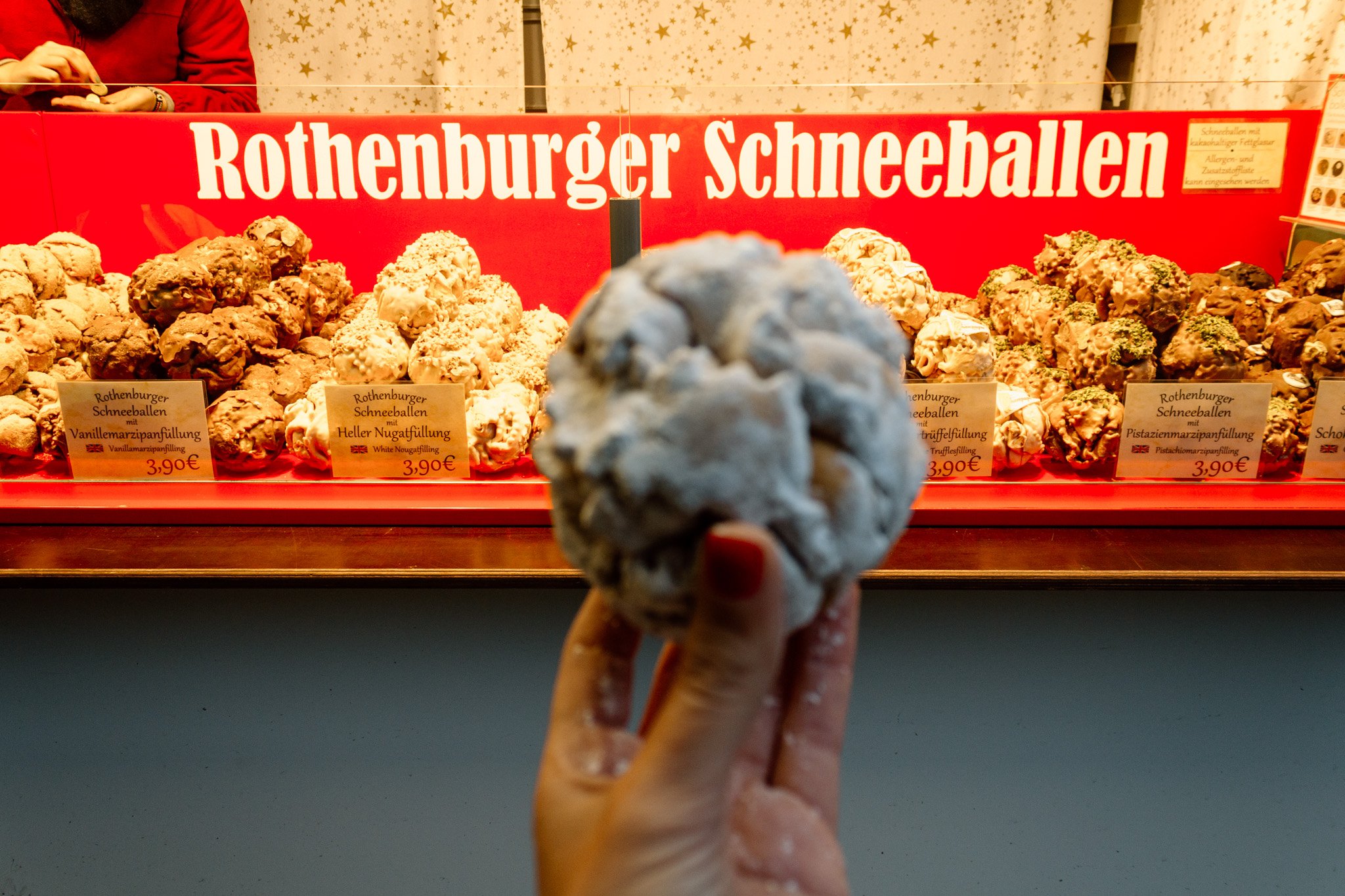26 Best Foods + Drinks to Try at a German Christmas Market: A Foodie Bucket List
If you’re visiting the Christmas markets in Germany, I’ve rounded up 26 of the best foods and drinks for you to try!
Across the years that I’ve sporadically lived in London, I’ve made a concerted effort to visit as many European Christmas markets as possible. And, while all of Europe’s Christmas markets stand out for one reason or another, the Christmas markets in Germany are all-over winners. Germans have nailed the lively holiday atmosphere, complete with twinkly light displays and mouthwatering food. In fact, German Christmas market food is in and of itself worth braving the marketplace crowds and freezing temperatures for.
German Christmas markets have the best selection of seasonal sweets and festive foods for travelers to sink their teeth into. I’ve rounded up the very best foods and most delicious drinks for adventurous palates to try at German Christmas markets. From seasonal sweets to scrumptious savories, this post includes them all.
foods to try at German Christmas markets ↴
Bratwurst + Currywurst
Wurst is the German word for sausage, a food dearly loved by most locals. You can find a neverending variety of wursts at the Christmas markets in Germany, from classic bratwurst to the white Weisswurst. If you’re a sausage fan, you’re in luck.
Currywurst is a more modern take on the traditional German bratwurst. A currywurst is a steamed pork sausage that is later fried and cut into slices. The slices of the sausage are covered in a ketchup sauce of sorts and sprinkled with curry powder. Usually, currywurst is served with bread of some kind so that you can soak up the sauce or make a sandwich. Unlike some of the dishes on this list with questionable origins, currywurst is undeniably German and, I’ve been told, undeniably delicious.
KäSESPäTZLE
Käsespätzle, which translates literally to mean “cheese noodles”, is a traditional dish found in the Bavaria region of Germany. It’s a take on macaroni and cheese, or rather macaroni and cheese is a take on käsespätzle. Hot noodles are covered with freshly grated cheese and crispy fried onion. Yes, it tastes as good as it sounds. No, it’s not calorie-light, but it will fill you up for festivities. The käsespätzle I’ve tried has a helping of spring onion and yellow onion. Portions are usually quite generous, and the dish itself is hearty, making it an ideal sharing plate.
Note: At some markets, you may be charged a fee for the fork and ceramic bowl containing your meal, but it’s just a deposit in case of loss or damage. You get your money back once you’ve finished eating and return your utensils.
Frikadella
Frikadella is the German equivalent of meatballs, made with either beef, pork, or veal. The meat is pan-fried and sometimes flattened. On rare occasions, you might see frikadella sold by vendors who coat it in breadcrumbs or serve it on miniature buns like sliders.
Pommes Frites
Pommes frites might not be a dish specific to Germany, but it’s a classic Christmas market snack that will warm your bones and fill your stomach. Expect the potato fries smothered in mayonnaise, cheese, or ketchup.
Raclette
The Germans can’t take credit for raclette, but they’ve certainly made it their own! Raclette originated as a delicacy in Switzerland. A wheel of cheese is heated and its melted part is scraped off to be served with potatoes and bread.
Dresdner Handbrot
Dresdner handbrot is easily one of my favorite German Christmas market foods. Stuffed bread? Say less. The doughy bread is stuffed and baked in the oven, then chopped into pieces and topped with a generous portion of sour cream and a sprinkling of chives. You might also find these topped with diced mushrooms and ham bits.
Maroni
What is more quintessentially “winter” than chestnuts roasting on an open fire? Maroni (aka roasted nuts) are sold by street vendors and at German Christmas market stalls all winter. If you’re looking for a unique souvenir, consider buying a bag of unroasted chestnuts to roast yourself.
Note: if you do decide to purchase nuts to take home, make sure they’re a legal import product. Most countries don’t allow nuts or fruit to be brought over borders, but it’s worth checking.
Reibekucken + Kartoffelpuffer
Kartoffelpuffer is highly popular with German Christmas marketgoers. The fried potato pancakes taste similar to crispy hash browns. Kartoffelpuffer is traditionally served with a side of homemade applesauce to cut the oiliness. Today at German Christmas markets, you’ll often be given a range of savory condiments to add on, like sour cream or chopped chives.
Lángos
Who doesn’t love fried dough? Originally from Hungary, lángos’ popularity spread to Germany and has become a staple of German Christmas markets. Deep-fried, served hot, and topped with sour cream, grated cheese, and chopped garlic, in my opinion, there is nothing not to like about lángos.
Flammkuchen
If you love pizza, flammkuchen is a must-try! A thin, flatbread base is topped with cheese, meat, and vegetables before being baked in the oven. The thin base means flammkuchen isn’t overly filling, so you can still indulge in other market foods.
Spiessbraten
Spiessbraten isn’t a common Christmas market food, but the pork fan-favorite can sometimes be found in sandwich form, served with grilled onions between brioche buns. The pork tenderloin is slow-cooked on a rotisserie over a hardwood fire. It’s a carnivore classic you’ll want to keep your eyes peeled for if you’re on the hunt for something salty and satiating.
PRETZEL
Pretzels have become synonymous with German food. But, did you know that the pretzel dates back to medieval European times? Greeks claim the pretzel as a deviation of their looped sesame seed bread and Italians also take credit for the tasty treat. But Germans stake their claim to the carb and believe that pretzels were the result of desperate bakeries in Germany being held hostage.
Whatever the origin story, pretzels can be found at every German Christmas market you wander through. Traditionally, pretzels are salted, but today, they’re dressed up in sweet and savory combinations that include cinnamon sugar, poppy seed, and cheese. I haven’t met a pretzel I didn’t like, especially when they’re served warm and the temperature is in the single digits.
seasonal sweet treats to try at German Christmas markets ↴
stollen/Christstollen
Starting this list of German Christmas market desserts off strong with Stollen, which is sometimes referred to as German Christmas Cake. The cake is surprisingly heavy, made with an absurd amount of butter and dusted with powdered sugar. Almonds, cinnamon, oranges, and lemon peels are other key ingredients in the festive food.
LEBKUCHEN
This is a special German Christmastime treat whose closest relative is gingerbread. Historians give Nuremberg the honor of being the home of the original lebkuchen. Some lebkuchen are small, like a typical cookie. Other times it comes in cake variations or cookies bigger than your head. You’ll find it at every German Christmas market decorated with colorful icing, but traditional lebkuchen stalls will serve up lebkuchen with powdered sugar dusting and almond slices or a drizzle of chocolate instead.
Our little Berlin insider, Alina, told me to save my money for better lebkuchen at a fraction of the cost from a supermarket. So, that’s just what we did. Luke, Ali, and I headed to a local supermarket to pick up two bags full of traditional chocolate-covered lebkuchen.
TRDeLNIK
Oh trdelnik, you very controversial little pastry, you. It turns out that, while Hungarians, Romanians, Swedes, and Russians like to take credit for the pastry, so do the Germans. The word trdelnik has Czech and Slovak origins, so perhaps that helps solve the mystery. However, even in saying that, many proud Czechs deny trdelnik as a traditional food and believe that it’s only been adopted as a national dessert for the sake of tourism.
Trdelnik is a seriously delicious treat, especially since it’s served warm! Trdelnik is a warm pastry, similar to a donut, in a spherical shape that is covered in cinnamon and sugar. You’ll find it drizzled with chocolate and caramel, sprinkled with nuts, and even filled with Nutella and ice cream.
Schneeballen
Schneeballen is what would be conceived if sugar, butter, eggs, flour, and cream made love with one another. Schneeball translates to “snowball” in English, and it’s an accurate name. These giant shortbread cookie balls are traditionally only dusted with powdered sugar, but can be found at Christmas markets these days in variations that include marzipan, chocolate, caramel, and nuts.
I found it easiest to eat the schneeballen by putting it in the paper bag it was sold in, breaking it into pieces, and eating the little bits rather than trying to take a bite out of the stiff cookie orb. Personally, as someone who prefers salt and spice, Schneeballen wasn’t for me. If you have a sweet tooth and want your cookie fix, however, a snowball is exactly what you’re looking for. Don’t worry about the mess- it’s part of the schneeballen fun!
Schaumkuss/Schokokuss
Imagine a warm marshmallow sitting on a wafer, then covered in chocolate and you have the makings of schaumkuss.
Germknödel
We have Bavaria and Austria to thank for germknödel. Germknödel is a fluffy dumpling filled with plum jam and served warm with melted butter. Poppy seeds and sugar are sprinkled on top to finish it off. I recommend pairing it with glühwien!
Marzipan
Most people don’t know that the invention of marzipan is attributed to Lübeck, Germany! It’s believed that during a famine in the 15th century, Lübeck bakers were ordered to develop a replacement for bread. Using eggs, sugar, and almonds, the bakers crafted what we know now as marzipan.
Apfelstrudel
One of my favorite wintertime treats is traditional German apfelstrudel. Spiced apples and raisins are tucked into a flaky crust and baked to golden brown perfection. The dessert’s origin can be traced back to the Austro-Hungarian Empire.
drinks to try at German Christmas markets ↴
GLüHWEIN
No trip to Germany’s Christmas markets would be complete without tasting glühwein! In other countries, you’ll find this called mulled wine in other places. In Germany, it’s exceptionally strong! Glühwein is made by warming red wine and adding mulling spices, fruits, and occasionally raisins.
Glühbier
Wine not your thing? Try glühbier, also known as mulled beer. Just like glühwein, glühbier is made by warming beer and adding spices like cinnamon and clove.
Jagertee
Jagertee is one of the more unique Christmas drinks you’ll find for sale at the markets. You can expect a (potent) combination of black tea and rum, served warm of course.
Kinderpunsch
If you prefer alcohol-free beverages, try kinderpunsch. This warmed punch is made by combining orange, cherry, and apple juices and adding in a concoction of cinnamon and clove. It isn’t light on the sugar, so don’t expect it to be a “healthier” alternative to glühwein, but it is free of booze.
Grog
One of Germany’s most simple Christmas drinks is grog. Hot water is mixed with warmed rum to create the ultimate alcohol blanket. It’s particularly popular in the Northern regions of Germany, where the temperatures are especially frigid.














